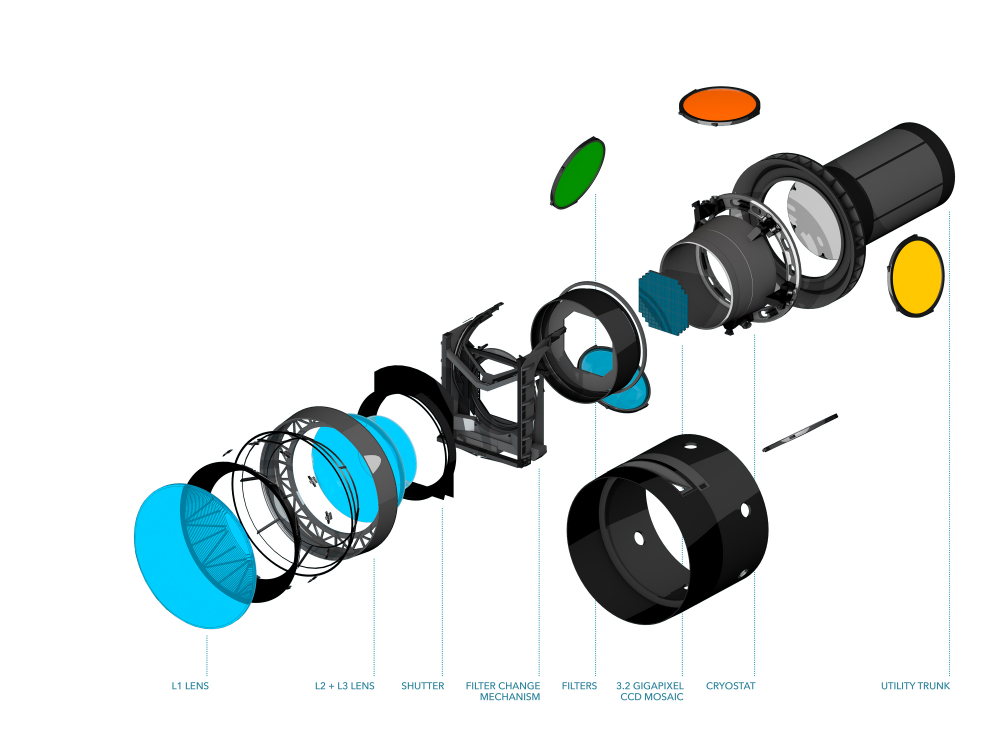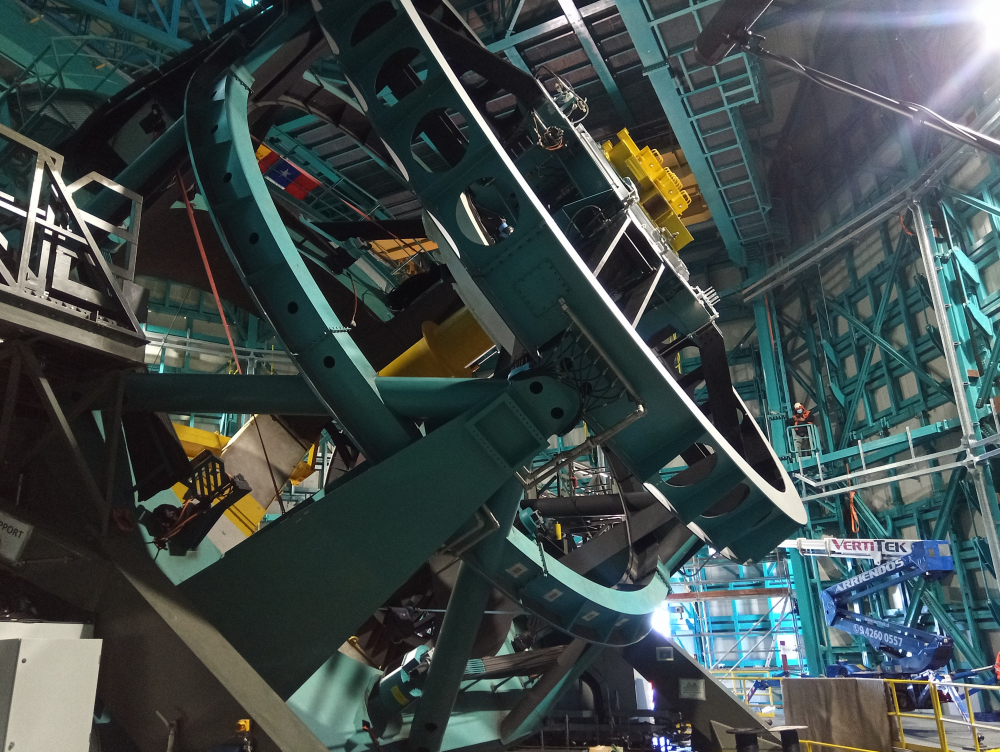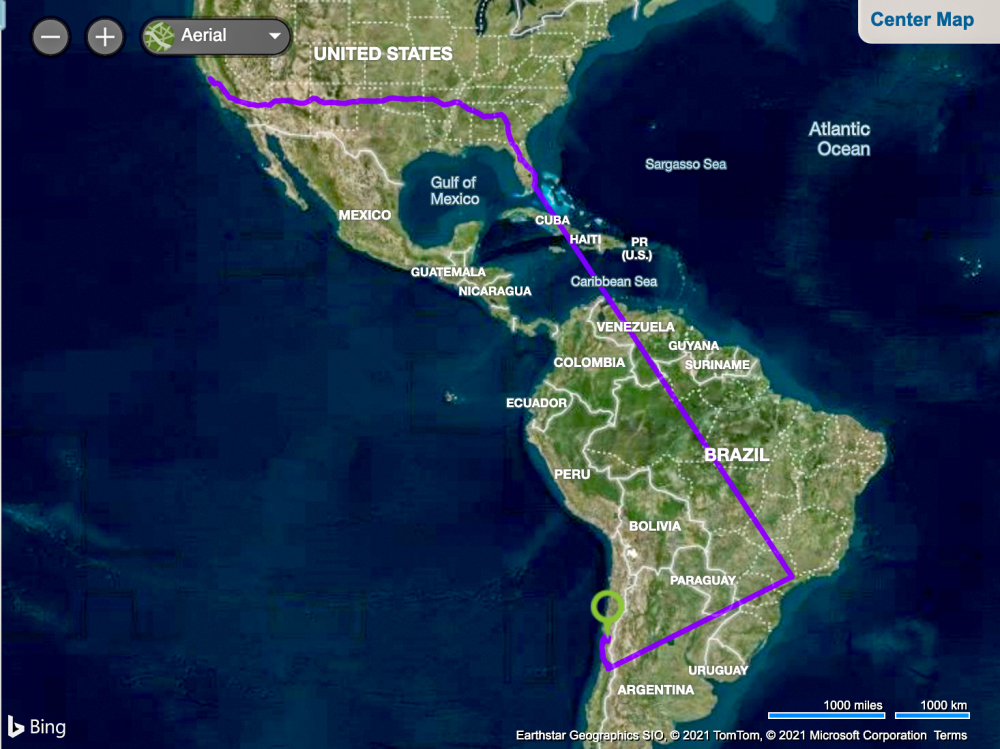At SLAC National Accelerator Laboratory, the integrated LSST Camera cryostat and utility trunk was successfully lifted onto its test bench in mid-August (photo here). The work was planned and executed by a team that included Rubin staff, SLAC Contract Assurance, SLAC Environment, Safety & Health (ES&H) and the Bay Area Site Office. This ~$100M assembly is the core of the final camera; it contains the 201 sensors and all the supporting electronics, vacuum and cooling on-camera systems. The installation of this assembly on the test bench will enable completion of the next phase of testing, before further integration of the LSST Camera.
The LSST Camera Major Item of Equipment (MIE) project Critical Design (CD)-4 independent project review was conducted on August 19th and confirmed completion of the Camera Department of Energy (DOE) Key Performance Parameters—a major step towards formally closing the MIE project. The remaining Camera work (completing the Camera integration and testing at SLAC, shipping, and commissioning it in Chile) will be done as part of the Rubin Observatory DOE Commissioning effort.
The Rubin Auxiliary Telescope (AuxTel) team conducted an observing run on August 17-19. The main goals for the run were to test new M1 mirror controls, take some science data to compare the performance of the currently installed gratings, and to train three new telescope operators (Bruno Quint, Ioana Sotuela, and Erik Dennihy). The weather during the run was uncooperative, which impacted the M1 mirror control testing and science data gathering (these activities will be a focus of the next observing run), but also allowed more time for explaining processes and answering questions, to the benefit of the new operators. The next AuxTel observing run is scheduled for September 7-10.
A team of workers from the Swedish company SKF arrived on the summit on August 23rd; they have begun activities to commission the hydrostatic oil bearings of Telescope Mount Assembly (TMA). The telescope is expected to begin moving in azimuth and elevation on a thin film of oil in early September. During July and August, parts of the TMA were painted with special low-reflectivity and low-emission coatings. These were applied to surfaces that face the light path (inward and skyward) to minimize stray light and other effects that could degrade imaging.
The Rubin Observatory/LSST Science Collaborations have partnered with the Heising Simons Foundation to support Rubin preparatory science focused on Solar system, Milky Way, variable stars and transients with a kickstarter grant program. The opportunity is highly flexible in terms of who can apply and what projects can be sponsored. Applications are due September 30th. More details about this opportunity, and about grant workshops being held on September 8th and 9th, are available at this link.
Four new staff highlights are now featured on the Rubin website. Read about your colleagues Oscar Nuñez, Nate Pease, Tiago Ribeiro, and Ian Sullivan on the Rubin website.
The next discussion in the Diversity, Equity, and Inclusion series will take place on September 13th. All are welcome; follow Rubin’s #inclusion Slack channel for updates and information on participating.
Rubin Observatory swag items, including t-shirts, coffee mugs, tote bags, and more, are available for purchase in our online store.
RUBIN IN THE MEDIA:
An article (in Spanish) that features Rubin Observatory as one of the exciting new observatories being constructed in Chile was published in the Chilean La Tercera newspaper recently. The article, titled “Chile Widens its Window to the Universe”, was coordinated by the press office of the Chilean Minister of Science, who visited the Rubin construction site a few weeks ago.
CORPORATION NEWS
A major new initiative will result in additional software to analyze the datasets from Rubin Observatory’s Legacy Survey of Space and Time (LSST). The effort will be led by LSST Corporation member institutions Carnegie Mellon University and the University of Washington. The Community Science and Data Center (CSDC) at NSF's NOIRLab will collaborate with the team to make the software freely available to the entire astrophysics community. Details are available at this link.
As part of ongoing efforts to fund the science of LSST at Rubin Observatory, the LSST Corporation announces its first corporate philanthropic partner; they are pleased to welcome Wasabi Technologies Inc. to the LSSTC Family. Wasabi Technologies, Inc. is an object storage service provider based in the US. Their support will help power a special Enabling Science grant of $25,000 for a member institution. Watch for news about this grant, coming soon.
PERSONNEL ANNOUNCEMENTS
Aren Heinze joined the Data Management team as Research Scientist on September 1st. Aren will be based at the University of Washington, responsible for developing and maintaining the Solar System Processing pipeline for the Legacy Survey of Space and Time (LSST).
Robinson Godoy joined the Telescope & Site group in Chile as Electronics Technician on September 1st. Robinson will be supporting integration and commissioning of the electronics systems for the main telescope as well as other facilities at the summit.
Peter Ferguson joined the Systems Engineering group on August 18th. Peter is a postdoc at the University of Wisconsin-Madison, focusing on Rubin Science Verification and Validation.
INFO FOR PROJECT MEMBERS
A new initiative has been introduced as part of the ongoing effort to improve workplace culture: an opportunity to meet one-on-one with Project leadership. If you would like to have a one-on-one meeting with Victor or Steve, please fill out this form to indicate your preferred (and backup) date and time.
UPCOMING MEETINGS with RUBIN OBSERVATORY INVOLVEMENT
(those with an asterisk* are LSSTC funded):
2021 | |
September 23, 24 & 27 | AURA Management Council for Rubin Observatory (AMCR) meeting, Virtual |
October 4-7 | Joint Status Review, Virtual |
October 25-29 | DESC Sprint Week, Virtual with in-person hubs at AstroParticule et Cosmologie (APC), France, Princeton University, and University of Illinois Urbana-Champaign (UIUC) |
NOTICIAS DEL PROYECTO Y DE LA CIENCIA
A mediados de agosto el criostato integrado de la Cámara LSST y la caja de utilidades se colocaron con éxito en su banco de pruebas en el Laboratorio Nacional de Aceleradores SLAC (foto aquí). El trabajo fue planificado y ejecutado por un equipo que incluyó a personal de Rubin, SLAC Contract Assurance, SLAC Environment, Safety & Health (ES&H) y la Oficina del Sitio en el Área de la Bahía. Este montaje de ~$100 millones de dólares, es la base de la cámara final; contiene 201 sensores y toda la electrónica de apoyo, los sistemas de vacío y refrigeración de la cámara. La instalación de este conjunto en el banco de pruebas permitirá completar la siguiente fase de pruebas, antes de continuar con la integración de la Cámara LSST.
Una revisión independiente del proyecto Major Item of Equipment (MIE) Critical Design (CD) -4 del proyecto de la Cámara LSST, se llevó a cabo el 19 de agosto y se confirmó el cumplimiento de los Parámetros Clave de Rendimiento de la Cámara del Departamento de Energía (DOE) –
un paso importante hacia el cierre formal del proyecto MIE. El trabajo restante de la Cámara (completar la integración y pruebas en SLAC, su envío y la puesta en servicio en Chile) se realizará como parte del esfuerzo de Puesta en Servicio de DOE y del Observatorio Rubin.
El equipo del Telescopio Auxiliar de Rubin (AuxTel) llevo a cabo una jornada de observación del 17 al 19 de agosto. Los principales objetivos de la jornada eran probar los nuevos controles del espejo M1, tomar algunos datos científicos para comparar el rendimiento de las rejillas instaladas actualmente y capacitar a tres nuevos operadores de telescopios (Bruno Quint, Ioana Sotuela y Erik Dennihy). El clima durante la jornada no cooperó, lo que afectó las pruebas de control del espejo M1 y la recopilación de datos científicos (estas actividades serán el foco de la próxima jornada de observación), pero en beneficio de los nuevos operadores, permitió más tiempo para explicar los procesos y responder preguntas. La próxima jornada de observación del AuxTel está programada del 7 al 10 de septiembre.
Un equipo de trabajadores de la empresa sueca SKF llegó al sitio el 23 de agosto y han comenzado las actividades para la puesta en servicio de los cojinetes hidrostáticos de aceite de la Montura del Ensamblaje del Telescopio (TMA). Se espera que el telescopio comience a moverse en azimut y elevación sobre una fina película de aceite a principios de septiembre. Durante julio y agosto, partes del TMA fueron pintados con revestimientos especiales de baja reflectividad y bajas emisiones. Estos se aplicaron a las superficies que miran hacia la trayectoria de la luz (hacia adentro y hacia el cielo) para minimizar la luz lateral y otros efectos que podrían degradar las imágenes.
Las Colaboraciones Científicas del Observatorio Rubin/LSST se han asociado con la Fundación Heising Simons para apoyar la ciencia preparatoria de Rubin enfocada en el sistema solar, la Vía Láctea, las estrellas variables y transitorias con un programa de subvenciones kickstarter. La oportunidad es muy flexible en términos de quién puede postular y qué proyectos pueden ser patrocinados. Las postulaciones son hasta el 30 de septiembre. Más detalles sobre esta oportunidad y sobre los talleres de subvenciones que se llevarán a cabo el 8 y 9 de septiembre, están disponibles en este enlace.
Quatro nuevos perfiles de personal destacado se encuentran en el sitio web de Rubin. Lea acerca de sus colegas Oscar Nuñez, Nate Pease, Tiago Ribeiro, e Ian Sullivan en el sitio web de Rubin.
La próxima discusión de Diversidad, Equidad e Inclusión se llevará a cabo el 13 de septiembre. Todos son bienvenidos; siga el canal de Slack #inclusion de Rubin para obtener actualizaciones e información sobre la participación.
Los artículos promocionales del Observatorio Rubin, que incluyen camisetas, tazones para café, bolsas de mano y más, están disponibles para su compra en nuestra tienda en línea.
RUBIN EN LOS MEDIOS
Recientemente se publicó en el periódico chileno La Tercera, un artículo (en español) que destaca al Observatorio Rubin como uno de los nuevos e interesantes observatorios que se están construyendo en Chile. El artículo, titulado “Chile Amplía su Ventanal al Espacio”, fue coordinado por la oficina de prensa del Ministro de Ciencia de Chile, quien visitó el sitio de construcción de Rubin hace unas semanas.
NOTICIAS DE LA CORPORACIÓN
Una nueva iniciativa importante dará como resultado un software adicional para analizar los conjuntos de datos de la Investigación de Espacio-Tiempo para la Posteridad (LSST) del Observatorio Rubin. El esfuerzo será dirigido por las instituciones miembros de la Corporación LSST como la Universidad Carnegie Mellon y la Universidad de Washington. El Centro de Ciencia y Datos Comunitarios (CSDC) de NOIRLab de NSF colaborará con el equipo para hacer que el software esté disponible para toda la comunidad astrofísica. Los detalles están disponibles en este enlace.
Como parte de los esfuerzos en curso para financiar la ciencia de LSST en el Observatorio Rubin, la Corporación LSST anuncia su primer socio filantrópico corporativo; se complace en dar la bienvenida a Wasabi Technologies Inc. a la familia LSSTC. Wasabi Technologies, Inc. es un proveedor de servicios de almacenamiento de objetos en Estados Unidos. Su apoyo ayudará a impulsar una subvención especial de Enabling Science de $25,000 dólares para una institución miembro. Próximamente, habrá más noticias sobre esta subvención.
ANUNCIOS DE PERSONAL
Aren Heinze se unió al equipo de Gestión de Datos como Investigador Científico el 1 de septiembre. Aren, con sede en la Universidad de Washington, es responsable del desarrollo y mantenimiento de los datoductos de procesamiento del sistema solar para la Investigación de Espacio-Tiempo para la Posteridad (LSST).
Robinson Godoy se incorporó al grupo Telescopio & Sitio en Chile como Técnico en Electrónica el 1 de septiembre. Robinson apoyará la integración y puesta en servicio de los sistemas electrónicos del telescopio principal, así como de otras instalaciones en el cerro.
Peter Ferguson se unió al grupo de Ingeniería de Sistemas el 18 de agosto. Peter es un postdoctorado en la Universidad de Wisconsin-Madison, y se especializa en la Verificación y Validación de la Ciencia de Rubin.
INFORMACIÓN PARA MIEMBROS DEL PROYECTO
Como parte del esfuerzo continuo para mejorar la cultura en el lugar de trabajo, se ha introducido una nueva iniciativa: una oportunidad para reunirse personalmente con los líderes del Proyecto. Si le gustaría tener una reunión individual con Victor o Steve, complete este formulario para indicar una fecha y hora preferida (y una alternativa).
PRÓXIMAS REUNIONES con PARTICIPACIÓN DEL OBSERVATORIO RUBIN
(aquellas con asterisco* son financiadas por LSSTC):
2021 | |
Septiembre 23, 24 & 27 | Reunión del Consejo de Gestión de AURA para el Observatorio Rubin (AMCR), Virtual |
October 4-7 | Revisión Conjunta de Estado, Virtual |
Octubre 25-29 | DESC Sprint Week, Virtual con centros presenciales en AstroParticule et Cosmologie (APC), Francia, Universidad de Princeton, y la Universidad de Illinois Urbana-Champaign (UIUC) |







